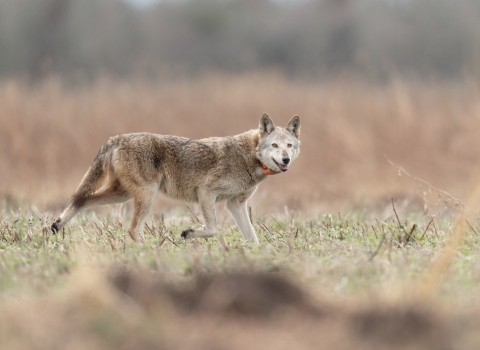DENVER – For the past three summers, many people have viewed and photographed grizzly bears near U.S. Highway 26/287 between Dubois and Moran Junction in the Togwotee Pass area in Wyoming. A female grizzly bear, known as “863” by wildlife managers and “Felicia” by public observers, and her cub, “Pepper,” have become habituated to the roadside along Highway 26/287. As more people have become aware of these bears, it has created unsafe conditions for people and wildlife. The public’s help is needed to ensure continued safety of these bears and people passing through the area.
The U.S. Fish and Wildlife Service, U.S. Forest Service, Wyoming Game and Fish Department, Wyoming Department of Transportation, and Wyoming Highway Patrol are unified in our approach and committed to ensuring safe conditions for people and wildlife. To achieve this goal, we need your help. Please remember to:
- Never approach bears: always stay at least 100 yards (300 feet) away from bears, about the length of a football field
- Never feed, leave food for or make food accessible to bears
- Obey traffic signs, laws and regulations
- Drive carefully, slowly and watch for wildlife on and near highways and roadsides
- Report any unlawful activity or dangerous situations to the State Agency Law Enforcement Communications System at 1-800-442-2767
As bears emerge from winter hibernation and become active over the coming weeks, drivers should stay alert and use caution. Violators can be cited and fined for harming, harassing, or feeding bears or for creating unsafe driving conditions.
The future of these grizzly bears is uncertain. Human behavior plays a big role. The more habituated bears become to humans and the road, the greater the odds of an accident.
Female bears can exhibit aggressive behaviors to defend their young from perceived threats. Increased human presence makes aggressive bear behavior more likely, and potentially dangerous, for bears and people. Once bears act aggressively towards humans, they must be removed by wildlife managers - using hazing, relocation, or euthanasia - to protect human safety. These actions are generally avoidable if people do not habituate bears to humans.
To safeguard human and bear safety, several law enforcement agencies are coordinating to help manage human-bear interactions along U.S. Highway 26/287. These agencies will apply applicable legal protections and Forest Orders to hold accountable anyone who knowingly harasses, harms, or feeds grizzly bears. Grizzly bears are currently protected under the federal Endangered Species Act and Wyoming state law. Law enforcement agencies will enforce other federal and state statutes and regulations as they relate to harming or harassing grizzly bears.
Illegal behaviors such as feeding bears threatens human and bear safety. Feeding bears can habituate bears to people and roadsides. Feeding bears can foster aggressive bear behavior and increases the chances of human-wildlife conflict. It is illegal to intentionally approach a grizzly bear or disrupt its normal behavior of feeding, breeding, or sheltering.
The Wyoming Department of Transportation will assist with protecting motorists and wildlife in the area by using signage to safely regulate traffic on U.S. Highway 26/287. The Wyoming Highway Patrol will monitor the highway to ensure compliance with state motor vehicle laws.
Stopping along the roadside to view bears can create dangerous driving conditions. It is unlawful to stop or park along the highway except in the case of an emergency or at designated pull off areas, such as scenic overlooks.
The mission of the U.S. Fish and Wildlife Service is working with others to conserve, protect, and enhance fish, wildlife, plants, and their habitats for the continuing benefit of the American people. For more information on our work and the people who make it happen in the West, visit our website, or connect with us through any of these social media channels: Facebook, Twitter, Flickr, YouTube, and Instagram.



